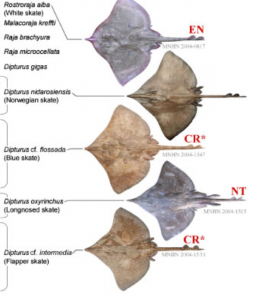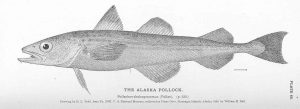What’s in a name? How common and scientific names affect conservation efforts
By Nicole Suren, SRC intern
Conservation efforts often focus on language to rally support for an ecological cause, and the names of what they are rallying support for are an integral part of that language. Both scientific and common names can have huge impacts on the success of conservation efforts, either by influencing the way the organisms are perceived by the public, or by being used to correctly or incorrectly identify a species to be conserved. Scientific names tend to be most important when examining the specificity of a name (i.e. how many names an organism has or whether a species has been named correctly), which can be integral in determining an organism’s conservation status. Common names are generally important in how the organism is perceived, affecting conservation in a completely different, and much more social way.
Scientific names, as one may intuitively be able to guess, are those most often used to identify individual species in scientific studies or by scientists, and always consist of two Latin names describing the genus and species. Because of their Latin roots, they are seldom used in common language and are rarely considered by non-scientists when thinking of the organism they describe. However, scientific names are very important in conservation because of their importance in correctly identifying and classifying organisms to determine how they should be managed, or whether they are recognized by policy makers as worthy of increased conservation measures. For example, the ICUN Red list, a comprehensive list of organisms that are facing the threat of extinction, is organized by scientific name (“ICUN Red List,” 2017), and this list is commonly used to determine which species or regions need to be more strictly managed. An example of a situation where the scientific name of a species was not used correctly was in the case of the European Common Skate. For decades, the European Common Skate was recognized as one species and considered critically endangered by the ICUN red list, but further studies revealed that it actually consisted of several species of skates that reached sexual maturity at significantly different sizes (Iglésias, Toulhoat, & Sellos, 2010). This misclassifying and misnaming of the species greatly affected the way the conservation needs of each type of skate were considered, and the discovery of the new species resulted in the need for a comprehensive reevaluation of conservation requirements for each species.

Dipturus flossada and Dipturus intermedia, the two skates previously thought to be a single species, along with other closely related species of skate (Iglésias, Toulhoat, & Sellos, 2010)
According to a culturomic study where presence of common and scientific names on the internet was used as a proxy for the presence of the named organisms in the general social consciousness, such a revision of scientific names can also reduce the cultural salience of an organism (Correia, Jepson, Malhado, & Ladle, 2017). This means that while the revision of the taxonomic status of a species can result in a heightened scientific awareness of the needs of that species, it can also result in a lowered social awareness, presenting a new conservation challenge even when progress in identifying needs has been made.
The words used to form common names are incredibly important in the way people perceive the organisms the names are describing. Generally speaking, common names can describe biological features, distribution, natural history, and/or phylogeny of the organism (Sarasa et al., 2012), and thus can be very informative on their own. However, particular words within a common name can greatly affect how much attention people believe the organism is worthy of receiving. For example, any organism with the word “rat” in its common name is less likely to receive positive human attention due to its common name being reminiscent of vermin, and the words “wild” or “feral” can also have negative connotations when the organisms are unfamiliar. So much so, that some conservationists are trying to change the common name of wild dogs to “painted hunting dogs” to avoid this negative perception (Sarasa et al., 2012). Another factor that can greatly affects the conservation goals of a species is how much its common name resembles that of a domesticated animal. According to the study by Sarasa et al., it seems that people tend to think animals with common names similar to domesticated animals deserve the treatment the domestic animals receive. This can be helpful in that people believe the animals should be conserved, but it can also be problematic because it also seems to make selective breeding programs in wild populations more acceptable. PETA seems to be using this principle in a recent marketing campaign it is calling “Save the Sea Kittens” (PETA, n.d.). The organizers of this campaign are pushing for fish to be renamed “sea kittens” under the premise that no one would hurt a kitten, and therefore they should be less likely to want to hurt a “sea kitten.” Whether this has been an effective ad campaign or has pushed this conservation naming principle beyond what is reasonable remains to be seen, but the idea remains the same: people want to protect their pets, and therefore would want to extend a similar protection to their pets’ close relatives.
Naming has been an especially effective marketing tool when it comes to fish, but it has been used to effectively oppose conservation rather than encourage it. Using the same principles of changing the common name of an organism to make it sound more appealing or likeable, companies that sell fish have been able to take species such as spiny dogfish and Patagonian toothfish and turn them into rock salmon and Chilean seabass, which are now recognized as bestsellers, and have been dangerously overfished (Logan et al., 2008). They have also been able to market groups of fish under one name. For example, “whitefish” can include halibut, Alaskan Pollock, sole, and cod. Including many fish under one name can also inhibit conservation efforts because it reduces consumer purchasing power in controlling options available on the market (Logan et al., 2008). When it is unclear what species are included in a package of “whitefish,” consumers no longer have the power to choose sustainably caught fish over endangered fish because they are sold without being able to discern between the two.

Alaskan Pollock, cod, or whitefish? Theragra chalcogramma goes by all three names (Wikimedia commons)
A catchy, likeable name can be the difference between wide-reaching notoriety, relative public invisibility, and reactions of disgust to the same organism, and the way this naming power has been used can be both beneficial and incredibly damaging to the conservation of the organism in question. Knowing the significant effect language can have on conservation efforts can be used both by scientists to help guide public opinion towards optimal conservation outcomes, and by the public as consumers and potential supporters of conservation efforts to look at purchasing options and conservation campaigns critically, and determine what the best course of action for them as consumers, citizen scientists, or voters may be.
References
Correia, R. A., Jepson, P., Malhado, A. C. M., & Ladle, R. J. (2017). Internet scientific name frequency as an indicator of cultural salience of biodiversity. Ecological Indicators, 78, 549–555. https://doi.org/10.1016/j.ecolind.2017.03.052
ICUN Red List. (2017). Retrieved January 1, 2017, from http://www.iucnredlist.org
Iglésias, S. P., Toulhoat, L., & Sellos, D. Y. (2010). Taxonomic confusion and market mislabelling of threatened skates: Important consequences for their conservation status. Aquatic Conservation: Marine and Freshwater Ecosystems, 20(3), 319–333. https://doi.org/10.1002/aqc.1083
Logan, C. A., Elizabeth Alter, S., Haupt, A. J., Tomalty, K., Palumbi, S. R., & Snapper Overfished, R. (2008). An impediment to consumer choice: Overfished species are sold as Pacific red snapper. Biological Conservation, 141, 1591–1599. https://doi.org/10.1016/j.biocon.2008.04.007
PETA. (n.d.). Save The Sea Kittens! Retrieved November 20, 2017, from http://features.peta.org/PETASeaKittens/
Sarasa, M., Alasaad, S., Jesú, @bullet, Pérez, M., Sarasa, M., Alasaad, Á. S., … Pérez, J. M. (2012). Common names of species, the curious case of Capra pyrenaica and the concomitant steps towards the “wild-to-domestic” transformation of a flagship species and its vernacular names. Biodivers Conserv, 21, 1–12. https://doi.org/10.1007/s10531-011-0172-3
Wikimedia Commons. https://commons.wikimedia.org/wiki/File:FMIB_50900_Alaska_Pollock.jpeg
